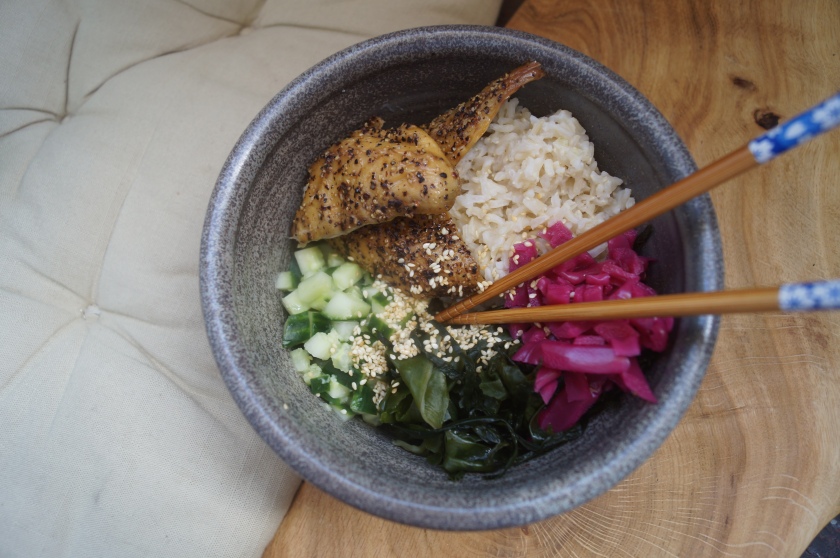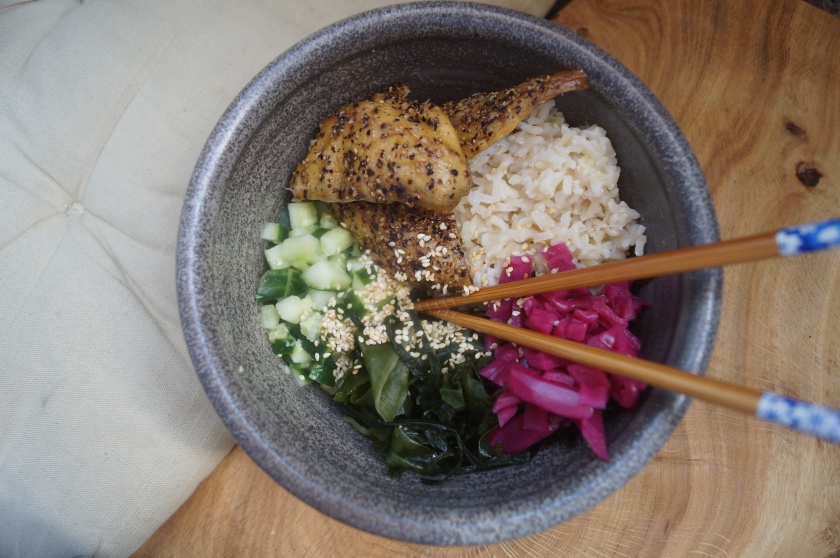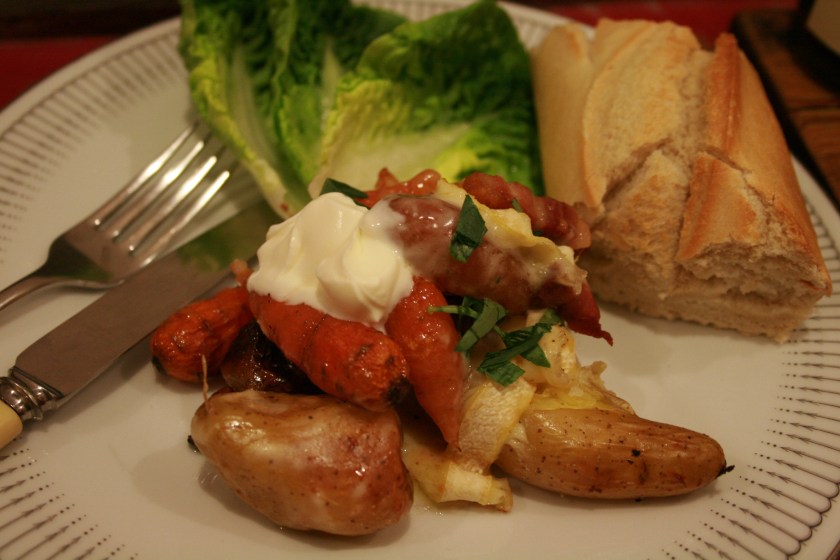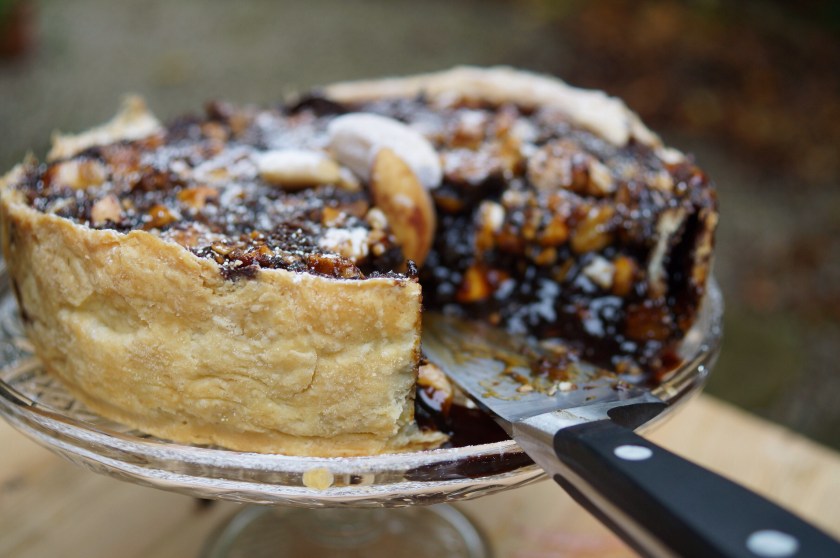A new #askmim request appeared in my inbox the other day, this one is from Veena. Ahoy there Veena!
Veena said:
“I’m a fish eating veggie and am going back to a really full on job after having a baby. I want to be able to cook something delicious and healthy when I get home, that isn’t pasta, and doesn’t mean that I spend ages in the kitchen away from my daughter when I should be spending time with her. Any ideas?”
Good challenge. Righteo, I’ve spent some time cooking up a few ideas this week and come up with 3 tasty new mid-week suggestions for you.


The first was inspired by some of my favourite sushi ingredients. You can vary it too though, tofu would be ace instead of mackerel and any green veg like spinach or green beans could take the place of the seaweed as it can be a bit tricky to get hold of.
Smoked Mackerel Sushi Bowl
Serves 1
Ingredients
75g brown rice (dried or a sachet of microwave brown rice)
chunk of cucumber (I used about 50g)
1/2 teaspoon of finely grated fresh root ginger
2 teaspoons of rice vinegar
1 tablespoon of toasted sesame seeds
1 or 2 smoked mackerel fillets
To serve
1 tablespoon of pickled red cabbage
a handful of dried seaweed (which has been rehydrated in some boiling water – check pack for guidance) or some wilted spinach
Method
1. If you’re using uncooked rice pop that on to boil for 20-25 mins (check the pack for proper timings). If you’re using the microwave kind (nowt wrong with that – check the pack but all they usually add is a dash of veg oil to stop it sticking together) heat that up at the last minute.
2. Next mix the cucumber, grated ginger and rice vinegar together in a nice bowl or soup dish then nudge it to one side to make space for everything else. Pile the cooked rice in down one side, tuck in the mackerel fillets, add the seaweed or spinach then the pickled cabbage and finally sprinkle the toasted sesame seeds over the rice. Add a spritz of soy sauce if you like but I’m not sure it’s necessary. Dig in!

Sometimes all I want for dinner is a big sandwich and this one is great as it’s so quick, filling and probably jolly healthy too as the fish is poached gently in water.
Poached Salmon Pittas
Serves 2
Ingredients
2 salmon fillets
5 black peppercorns
1 tablespoon of Greek yogurt or sour cream
handful of soft fresh herbs (I used a mix of dill and basil but parsley, chives or tarragon would also be fine)
2 wholemeal pitta bread
handful of salad leaves
1/2 punnet of salad cress
Method
1. Half fill a deep sided sauté pan or medium sized saucepan with water and add the peppercorns. Bring to the boil then add the salmon fillets. Turn the heat right down and simmer gently for about 10 minutes or until the salmon is just cooked through and when you break a piece off the flesh is opaque pink.
2. Take the salmon out of the water with a slotted spoon, discard the peppercorns and leave the fish to rest just while you pop the pitta bread in the toaster.
3. Chop the herbs with scissors and stir into the sour cream or yoghurt. When the pitta is ready, cut a slit in each one along one of the long sides and divide the herby mixture between them.
4. Peel the skin away from the salmon (if it had it on) then gently break the fish into pieces and put them inside the pittas. Stuff with salad leaves, sprinkle in the cress and serve.

And finally a bit of a treat, even midweek…perhaps especially midweek! Pretty much everything on this platter keeps really well in the fridge, so can be hurled together whenever you need a little lift, like your own mini party!
Storecupboard Mezze
Ingredients
1 espresso cupful of couscous
1 tablespoon of light tahini
pinch of smoked paprika
3 mini crisp breads or 1 flatbread of your choice
few olives
few sundried tomatoes
1-2 tablespoons of feta cheese
1 teaspoon of pomegranate molasses
1/2 an avocado
Method
1. Pour the couscous into a heatproof bowl then add 1 1/2 espresso cupfuls of boiling water. Leave to stand whilst you prepare the rest.
2. In a small bowl mix the tahini with enough cold water to make a houmous-like consistency. Keep mixing until it’s nice and smooth then sprinkle the smoked paprika on the top and if you like a little drizzle of the oil from the sundried tomatoes.
3. Once the couscous has absorbed the water, fluff it up a bit using a fork to break up the grains then add the feta and the pomegranate molasses.
4. Pop everything else on a platter and dig in, cold glass of something lovely (alcoholic or otherwise) is a jolly nice addition.

Hope you like the recipes, do let me know what you think x
If you would like me to write a recipe for you too or answer a burning kitchen conundrum please get in touch via facebook, instagram or twitter using the hashtag #askmim.





















































![DSC07820[1]](https://miriamnice.com/wp-content/uploads/2014/02/dsc078201.jpg?w=840)
![DSC07822[1]](https://miriamnice.com/wp-content/uploads/2014/02/dsc078221.jpg?w=840)
![DSC07826[1]](https://miriamnice.com/wp-content/uploads/2014/02/dsc078261.jpg?w=840)
![DSC07827[1]](https://miriamnice.com/wp-content/uploads/2014/02/dsc078271.jpg?w=840)
![DSC07835[1]](https://miriamnice.com/wp-content/uploads/2014/02/dsc078351.jpg?w=840)
![DSC07838[1]](https://miriamnice.com/wp-content/uploads/2014/02/dsc078381.jpg?w=840)
![DSC07846[1]](https://miriamnice.com/wp-content/uploads/2014/02/dsc078461.jpg?w=840)
![DSC07851[1]](https://miriamnice.com/wp-content/uploads/2014/02/dsc078511.jpg?w=840)
![DSC07860[1]](https://miriamnice.com/wp-content/uploads/2014/02/dsc078601.jpg?w=840)
![DSC07848[1]](https://miriamnice.com/wp-content/uploads/2014/02/dsc078481.jpg?w=840)








